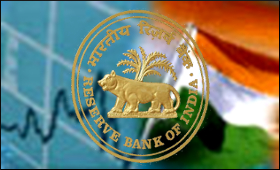|

|
RBI leaves policy rates unchanged
|
|

|
|
| Top Stories |
 |
|
|
|
SME Times News Bureau | 03 Jun, 2014
The Reserve Bank of India (RBI) Tuesday kept key policy rates unchanged but slightly reduced the money commercial banks have to mandatorily hold, indicating it will await further signals from the economy and the national budget next month before acting.
While the cash reserve ratio was kept unchanged at 4 percent, statutory liquidity ratio (SLR), which is the quantum of liquid assets banks have to hold against their deposits, has been reduced by 50 basis points to 22.5 percent.
In the second bi-monthly monetary policy review for this fiscal, and the first after the Narendra Modi government took charge last month, Reserve Bank of India Governor Raghuram Rajan's stance has been status quo given the current domestic and overseas conditions.
The prevailing policy rates are: bank rate 9.0 percent, repurchase rate 8 percent, reverse repurchase rate 7 percent and marginal standing facility rate 9.0 percent.
The repurchase rate is the interest commercial banks pay for borrowing money from the central bank to meet short-term fund requirements. The reverse repurchase rate is the interest central bank pays when surplus short-term funds are parked with it by banks.
The central bank, however, cut the liquidity provided under the export credit refinance facility from 50 percent of eligible export credit outstanding to 32 percent. This, in effect, reduces the amount of money available to exporters as credit.
"If the economy stays on this course, further policy tightening will not be warranted. On the other hand, if disinflation, adjusting for base effects, is faster than currently anticipated, it will provide headroom for an easing of the policy stance," Rajan said.
His reference was to the current spike in retail inflation due to sharp increase in food prices, and the central bank's stated objective to keep the economy on a disinflationary course by lowering such inflation to 8 percent by January 2015 and 6 percent a year after.
Rajan listed some upside risks to the economy: A sub-normal or delayed monsoon due to El Nino effect, impact of geo-political tensions on fuel prices and uncertainties over the government's administered prices for various commodities.
At the same time, he also felt these appear to have been balanced by the possibility of stronger action on food supply, better fiscal consolidation and recent appreciation in the value of Indian rupee.
"Accordingly at this juncture, it is appropriate to leave the policy rate unchanged, and to allow the disinflationary effects of rate increases undertaken during September 2013-January 2014 to mitigate inflationary pressures in the economy," he said.
"Contingent upon the desired inflation outcome, the April projection of real GDP growth from 4.7 percent in 2013-14 to a range of 5-6 percent in 2014-15 is retained with risks evenly balanced around the central estimate of 5.5 percent."
He also nudged the government to do its bit like easing domestic supply bottlenecks and proceed with reviving stalled projects which should should brighten the outlook for both manufacturing and services. The resumption of export growth is a positive, he added.
The stock markets, for a moment, did not take kindly to the apex bank's policy stance. The key sensitive index (Sensex) of the Bombay Stock Exchange (BSE) even fell 30 points. But it immediately staged a recovery and was up 35 points half-hour after the policy review.
|
|
|
| |
|
|
|
|
|
|
|
|
|
|
|
|
|
|
| |
| Customs Exchange Rates |
| Currency |
Import |
Export |
US Dollar
|
66.20
|
64.50 |
UK Pound
|
87.50
|
84.65 |
Euro
|
78.25
|
75.65 |
| Japanese
Yen |
58.85 |
56.85 |
| As on 13 Aug, 2022 |
|
|
| Daily Poll |
 |
 |
| PM Modi's recent US visit to redefine India-US bilateral relations |
|
|
|
|
|
| Commented Stories |
 |
|
|
|
|
|
| |
|